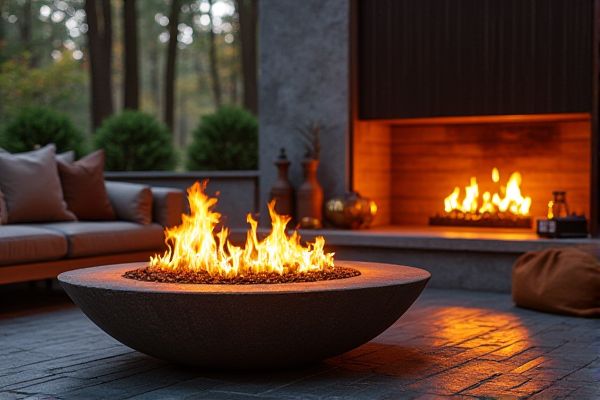
Wood burning fire pits offer a traditional, smoky aroma and a crackling ambiance that enhances outdoor gatherings, while gas fire pits provide convenient ignition, consistent heat, and low maintenance without the mess of ash and smoke. Discover which fire pit suits your lifestyle and outdoor space by exploring the detailed comparison in the rest of this article.
Table of Comparison
| Feature | Wood Burning Fire Pit | Gas Fire Pit |
|---|---|---|
| Fuel Type | Natural wood logs | Natural gas or propane |
| Installation | Simple, portable options | Requires professional gas line installation |
| Heat Output | High, radiates natural warmth | Consistent, adjustable flame control |
| Maintenance | Requires ash cleanup, chimney care | Minimal, occasional burner cleaning |
| Environmental Impact | Produces smoke and particulate matter | Cleaner burning, lower emissions |
| Cost | Lower upfront cost, ongoing wood purchase | Higher initial cost, lower fuel cost over time |
| Ambiance | Authentic crackling flame, natural scent | Controlled flame, less smoke and odor |
| Safety | Open flames, sparks risk | Safer with proper ignition and shutoff |
Introduction to Wood Burning and Gas Fire Pits
Wood burning fire pits create an authentic outdoor experience with natural crackling flames and smoky aromas, perfect for those who value traditional campfire ambiance. Gas fire pits offer cleaner, smokeless flames with easy ignition and precise temperature control, ideal for users seeking convenience and low maintenance. Your choice affects installation, fuel cost, emission levels, and overall user experience in backyard heating and entertainment.
Installation and Setup Requirements
Wood burning fire pits require a stable, non-combustible surface and proper clearance from structures, along with access to sufficient ventilation for smoke dissipation. Gas fire pits need a gas line connection or propane tank setup, usually demanding professional installation to ensure safety and compliance with local codes. Both options benefit from fire-resistant materials but vary in complexity and regulatory considerations during installation.
Environmental Impact and Sustainability
Wood burning fire pits release higher levels of carbon dioxide, particulate matter, and other pollutants, contributing to air quality degradation and increased greenhouse gas emissions. Gas fire pits, utilizing propane or natural gas, offer a cleaner alternative with significantly lower emissions and improved combustion efficiency, supporting better environmental sustainability. Your choice impacts air quality and carbon footprint, making gas fire pits a more eco-friendly option for outdoor heating.
Cost Comparison: Upfront and Ongoing Expenses
Wood burning fire pits have lower upfront costs, often priced between $100 and $500, but ongoing expenses include purchasing firewood and potential chimney cleaning. Gas fire pits typically require a higher initial investment ranging from $500 to $2,500 due to installation and equipment, while ongoing costs primarily involve propane or natural gas fuel, which tends to be more predictable and convenient. Your choice will depend on whether you prioritize lower initial expenditure or ease of maintenance and consistent fuel costs.
Heat Output and Efficiency
Wood-burning fire pits typically produce radiant heat ranging from 20,000 to 60,000 BTUs per hour, but much of the heat dissipates upward due to open airflow, resulting in lower overall efficiency. Gas fire pits offer a more controlled heat output between 30,000 and 50,000 BTUs per hour with higher combustion efficiency, converting almost all fuel into usable heat while minimizing smoke and ash. The efficient heat distribution of gas fire pits makes them more effective for sustained warmth in outdoor settings compared to traditional wood-burning models.
Operation, Convenience, and Ease of Use
Wood-burning fire pits require manual ignition and frequent wood replenishment, demanding more attention during operation, while gas fire pits operate with a simple ignition system and adjustable flame control that enhances convenience. Gas fire pits offer easier maintenance and cleaner burning, producing less smoke and ash, making them ideal for users seeking hassle-free fire features. You can enjoy instant warmth and longer burn times with gas options, whereas wood fire pits provide a traditional experience with natural crackling sounds but require more effort to manage.
Safety Considerations for Each Type
Wood burning fire pits require careful attention to ember control, proper ventilation, and maintaining a safe distance from combustible materials to prevent accidental fires. Gas fire pits offer enhanced safety through controlled flames and the ability to quickly shut off the gas supply, reducing the risk of uncontrolled sparks and smoke inhalation. Both types benefit from regular maintenance and adherence to local fire codes to ensure safe operation.
Maintenance and Cleaning Differences
Wood burning fire pits require frequent removal of ash and debris, and chimney or vent cleaning to prevent soot buildup and ensure proper airflow, whereas gas fire pits demand less frequent maintenance with occasional inspection of burners and gas lines for leaks or blockages. Gas fire pits typically have easier cleaning processes since they produce little to no residue, reducing the time and effort involved in upkeep. Regular maintenance of both types extends lifespan, but wood burning fire pits necessitate more intensive cleaning due to combustion byproducts.
Ambiance and Aesthetic Appeal
Wood burning fire pits offer a natural crackling sound and flickering flames that create a rustic, cozy ambiance ideal for traditional outdoor settings. Gas fire pits provide consistent, clean-burning flames with customizable flame height, offering a modern and sleek aesthetic perfect for contemporary patios. Your choice depends on whether you prefer the authentic warmth and aroma of wood or the convenience and design versatility of gas.
Choosing the Right Fire Pit for Your Needs
Wood burning fire pits offer an authentic crackling experience and smoky aroma, perfect for those seeking natural ambiance and traditional warmth. Gas fire pits provide easy ignition, adjustable flames, and clean burning, ideal for low-maintenance convenience and urban settings. Consider your space, usage frequency, and local regulations to determine whether wood or gas better matches your lifestyle and safety preferences.
 homyna.com
homyna.com